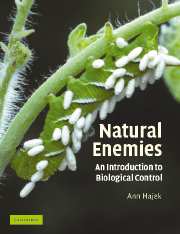Book contents
- Frontmatter
- Contents
- Preface
- Acknowledgments
- Introduction
- PART I Strategies for using natural enemies
- PART II Biological control of invertebrate and vertebrate pests
- PART III Biological control of weeds
- PART IV Biological control of plant pathogens and plant parasitic nematodes
- PART V Biological control: concerns, changes, and challenges
- Glossary
- References
- Index
PART I - Strategies for using natural enemies
Published online by Cambridge University Press: 05 June 2012
- Frontmatter
- Contents
- Preface
- Acknowledgments
- Introduction
- PART I Strategies for using natural enemies
- PART II Biological control of invertebrate and vertebrate pests
- PART III Biological control of weeds
- PART IV Biological control of plant pathogens and plant parasitic nematodes
- PART V Biological control: concerns, changes, and challenges
- Glossary
- References
- Index
Summary
Just as you find different types of pests with different attributes in different ecosystems, control strategies that are most appropriate for these different circumstances also vary. For example, the same goals and methods would not apply for control of mosquitoes inhabiting a long-lived forest on a nature preserve as for control of an aphid species in an agricultural monoculture of corn plants. In this example, the damage from the pests differs as mosquitoes are a public health problem and our tolerance to the presence of mosquitoes is usually low. Aphids attack plants and, if they aren't vectoring plant diseases, aphids must reach high population densities before they cause significant plant damage. The ecosystems in this example also differ because a nature preserve is more permanent while a corn crop in an agricultural field is temporary. Therefore, for the preserve, controls that operate over the long term could be appropriate, while for the monoculture that will be disrupted when harvested, permanence of control is often not important.
As interest in use of biological controls has grown, strategies for using biological control agents in very different ways to suit different needs have been developed. These vary in factors such as the source and types of natural enemies, whether natural enemies are released or resident natural enemies are manipulated and whether control is immediate or long term. Strategies can be grouped into four major categories: classical biological control, inoculative biological control, inundative biological control, and conservation biological control (Eilenberg et al., 2001).
- Type
- Chapter
- Information
- Natural EnemiesAn Introduction to Biological Control, pp. 37 - 38Publisher: Cambridge University PressPrint publication year: 2004



